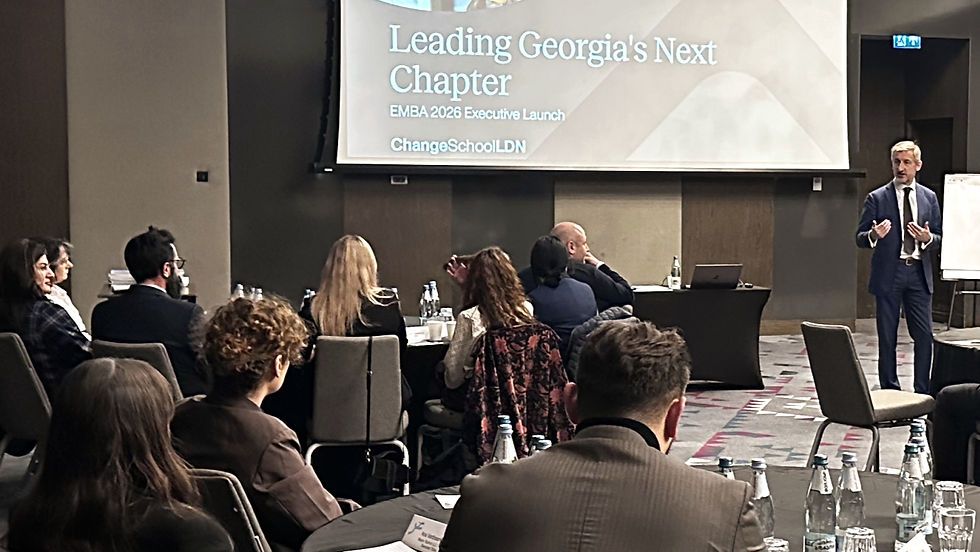Grounded in Doha: What a Travel Disruption Reveals About Strategic Risk
- sofiajones1
- Aug 4
- 6 min read
Updated: Aug 18
A few weeks ago, at the end of June, your correspondent was on his way from London to visit friends and clients in Armenia, Georgia, Kazakhstan and Uzbekistan. I was looking forward to meeting many new and old colleagues and holding a couple of large events focused on the developments companies want to make in areas such as succession planning, talent retention and the development of leadership and management skills.
Then the world intervened. You may remember that at the same time, a moment when Israel, Iran, and the United States had something of an argument. It was thankfully brief, but it was at that very time that I was changing aircraft at Doha Airport. Qatar sensibly closed its airspace, and I ended up stranded at the airport for two and a half days before I had to return home. What happened to me, and to hundreds of others stranded in Doha, was more than a travel inconvenience; it was a clear example of strategic risk unfolding in real time.

What follows is purely a theoretical assessment based on what I saw on the ground. In fairness to Qatar Airways, I know nothing about their strategic or board operations and plans, nor am I privy to their disaster recovery process or the measures they took on the ground at the time. Some of the recommendations below I did see implemented, such as vouchers to stranded passengers. Others may well have been in the background, and none of them are easy or quick to make happen.
Let's look at the Qatar Airways example from a month ago through the lens of strategic risk, the sort of thing that Professor Chris van der Hoven focuses on in our strategy module of the Executive MBA. An important caveat here.
What has an airport delay got to do with strategic risk?
Well, it's a nice, if small-scale, illustration of events outside of your control. "Events, dear boy, events", according to Harold MacMillan, UK Prime Minister from 1957 to 1963, what was the thing most likely to blow a government off course, and the same is true of any international business. In an increasingly erratic world, strategic risk management is a vital part of a board's focus. The situation is a great example of a modern strategic risk. It is not a failure that could have been prevented with better rules, but an external shock that tests the core of an organisation's resilience.
Using the Kaplan and Mikes framework, this event is a classic External Risk: a geopolitical disaster beyond the airline's direct influence or control. However, the subsequent 4-day backlog and 1-day service with limited food and water collapse shows that what there is to manage is the impact of that risk, a preventable risk that a resilient organisation can mitigate.
The event also illustrates the concept of Knightian Uncertainty or a "Black Swan" event. While the possibility of regional conflict is a known risk, its specific timing, nature and impact are fundamentally unpredictable. Therefore, the goal for Qatar Airways is not to predict this exact event, but to build a system that is prepared for a wide range of disruptions to its Doha hub.
Part 1: Proactive Measures. Example steps to Take Beforehand to build Strategic Resilience
Integrate Geostrategic Analysis into Core Strategy: A modern airline, especially one with a geopolitically central hub, must treat geostrategy as a core business function. The board must task management with incorporating geopolitical analysis directly into strategic planning, designing a more resilient network in response to the risks.
Scenario Planning and War-Gaming: "What is our plan if Hamad International Airport is rendered unusable for 24, 48, 72 hours or more due to conflict, natural disaster or a major cyberattack?". This exercise would stress-test every facet of the operation, from flight and crew rerouting to passenger communications and ground support and reveal weaknesses in the existing model before a real crisis exposes them.
Build Antifragile Operations: The core lesson from thinkers like Nassim Taleb is to build systems that can gain from disorder, or at least withstand it better, by having more options. A fragile system is one that is hyper-optimised for a single, stable future. An antifragile or resilient one has built-in flexibility.
For Qatar Airways, this could mean:
Hub Diversification: Establishing formal, pre-negotiated agreements with other airports in the region (e.g., in the UAE, Oman, or Kuwait) to act as designated relief hubs. This would include pre-arranged ground handling contracts, landing slots, and passenger processing protocols that could be activated instantly.
Fleet & Crew Flexibility: Investing in cross-training for pilots and cabin crew across different aircraft types to maximise scheduling flexibility during a crisis.
Technological Investment: Deploying advanced analytics and AI-powered systems capable of re-planning thousands of flights, crew schedules, and passenger itineraries in real-time, rather than relying on static models that are quickly overwhelmed.
Part 2: Reactive Measures (improving service in the aftermath)
A crisis is the ultimate test of the resilience you have built. The goal in the aftermath is not just to manage the chaos, but to do so in a way that preserves, and can even enhance, customer trust.
Activate Pre-Planned, Transparent Communication Protocols: The biggest failure in such events is often a vacuum of information, which breeds passenger frustration and anger. The war-gaming exercises would produce a clear crisis communication plan. This plan would be activated immediately to provide clear, consistent and empathetic updates across every channel: the airline's app, website, social media, and crucially, through empowered staff on the ground. This aligns with the "Information and Communication" component of the COSO framework, which is critical for managing operational and reputational risk.
Empower Frontline Staff: A 4-day backlog creates immense pressure on ground staff. A resilient organisation fosters a culture where frontline employees are empowered to solve problems. Staff should have the authority and tools to make immediate decisions regarding rebooking, hotel vouchers, and meal provisions without needing to escalate every case. This requires a culture of trust and a clear set of emergency guidelines, moving beyond a rigid, rules-based approach that paralyses action.
Execute on Operational Optionality: This is where the proactive planning pays off. Instead of cancelling flights and telling passengers to wait, a resilient Qatar Airways would:
· Immediately begin rerouting flights and passengers through its pre-designated relief hubs.
· Proactively charter aircraft or form emergency partnerships with other carriers to move stranded passengers.
· Use its advanced analytic tools to offer passengers automated rebooking options via the app, reducing the strain on call centres and airport staff.
Conduct a "Post-Mortem" to "Bounce Forward": True resilience is about adapting and improving from shocks. After the crisis subsides, the board must oversee a thorough review of the response. This is not about assigning blame but about learning. The insights gained should be used to refine the scenario plans, strengthen contingency agreements, and improve communication protocols. This process of learning from stress is what allows an organisation to become stronger and more antifragile over time, turning a potentially catastrophic failure into a source of long-term competitive advantage.
We've introduced a number of frameworks that help with dealing with extreme events such as these. These frameworks are typically taught in scenario planning, strategic planning, war gaming and other extreme event planning activities and are a part of great MBA education programmes that can help develop leaders and managers, giving them insights and tools to step away from the operational happy parts (when everything is going well) to how to show up and manage when events require crisis management through a set of both well-defined rules and leadership principles
Risk is real and more important than ever. Your customers won't judge you for falling victim to a "black swan" event but they will judge you on how you deal with that event and support them through its consequences.
Find out more about our executive MBA programme and how it can empower your organisation to manage risks here
References
A proactive approach to navigating geopolitics is essential to thrive – McKinsey, accessed on July 18, 2025. https://www.mckinsey.com/capabilities/geopolitics/our-insights/a-proactive-approach-to-navigating-geopolitics-is-essential-to-thrive
Global Risks Report 2024 | World Economic Forum, accessed on July 18, 2025. https://www.weforum.org/publications/global-risks-report-2024/digest/
Explore why boards must improve their resilience | EY - Global, accessed on July 18, 2025. https://www.ey.com/en_gl/global-board-risk-survey/what-if-the-difference-between-adversity-and-advantage-is-a-resilient-board
McKinsey on Risk & Resilience | Number 16, April 2024, accessed on July 18, 2025. https://www.mckinsey.com/capabilities/risk-and-resilience/our-insights/mckinsey-on-risk/mckinsey-on-risk-number-16
2023-global-risk-survey.pdf – PwC, accessed on July 18, 2025. https://www.pwc.com/gx/en/issues/risk-regulation/2023-global-risk-survey.pdf
Economic conditions outlook, 2024 – McKinsey, accessed on July 18, 2025. https://www.mckinsey.com/capabilities/strategy-and-corporate-finance/our-insights/economic-conditions-outlook-2024
Geopolitical Risk and Inflation Top Supply Chain Concerns in 2025 – Risk Management Magazine, accessed on July 18, 2025. https://www.rmmagazine.com/articles/article/2025/06/24/geopolitical-risk-and-inflation-top-supply-chain-concerns-in-2025
Appendix B: Global Risks Perception Survey 2023–2024 – World Economic Forum, accessed on July 18, 2025. https://www.weforum.org/publications/global-risks-report-2024/in-full/appendix-b-global-risks-perception-survey-2023-2024/
How supply chains need to adapt to a shifting global landscape – World Economic Forum, accessed on July 18, 2025. https://www.weforum.org/stories/2025/06/how-supply-chains-need-to-adapt-to-a-shifting-global-landscape/
Risk & Resilience Insights | McKinsey & Company, accessed on July 18, 2025. https://www.mckinsey.com/capabilities/risk-and-resilience/our-insights
How to manage geopolitical risk in the new era of globalization – EY, accessed on July 18, 2025. https://www.ey.com/en_us/insights/strategy/book-on-geostrategy-by-design
Antifragile by Nassim Nicholas Taleb (Ebook) – Everand, accessed on July 18, 2025. https://www.everand.com/book/769295771/Antifragile-Things-That-Gain-from-Disorder
Antifragile: Things That Gain from Disorder by Nassim Nicholas Taleb – Goodreads, accessed on July 18, 2025. https://www.goodreads.com/book/show/13530973-antifragile
Global Risks Report 2024 – Executive Summary – Marsh McLennan, accessed on July 18, 2025. https://www.marshmclennan.com/assets/insights/publications/2024/global-risks-report-2024/World_Economic_Forum_Global_Risks_Report_2024_Executive_Summary.pdf
Global Risk Management Survey | Aon, accessed on July 18, 2025. https://www.aon.com/en/insights/reports/global-risk-management-survey
Unpacking COSO's New Guidance on Internal Control Over Sustainability Reporting (ICSR), accessed on July 18, 2025. https://www.workiva.com/blog/unpacking-cosos-new-guidance-internal-control-over-sustainability-reporting-icsr
Managing Risk the Smart Way | IBM Center for The Business of Government, accessed on July 18, 2025. https://www.businessofgovernment.org/blog/managing-risk-smart-way
Managing Risks: A New Framework – Harvard Business School, accessed on July 18, 2025. https://www.hbs.edu/faculty/Pages/item.aspx?num=42549
2024 Global Corporate Treasury Survey | Deloitte US, accessed on July 18, 2025. https://www.deloitte.com/us/en/services/consulting/articles/global-corporate-treasury-survey.html



